Exploring the Culinary Heritage of Punjab: Flavours from Tandoors and Chullas

Aloo Parantha with Makkhan (butter)
Punjab is the land of five rivers and is known for its vibrant culture and world-famous Sikh shrine, Harmandir Sahib (Golden Temple) in Amritsar. Food in Punjab is considered to be a gift of God and treated with respect.
The soil of Punjab is ideal for growing wheat, rice, sugarcane, millet, barley, bajra and jowar. Punjabi dishes are majorly made out of fresh produce, dairy and locally grown crops which are high in macro and micronutrients. Onion, tomatoes, garlic and ginger are widely used to prepare various dishes. Some of the other common ingredients are mustard oil, vinegar, zarda (a coloring agent), fenugreek seeds, cumin, dried coriander seeds, and black pepper. Punjabi cuisine contains a variety of vegetarian and non-vegetarian dishes, prepared traditionally.
The most common Punjabi breakfast dishes are daliya (porridge), aloo or gobhi parantha with lassi and unprocessed butter. The regular dishes for lunch are wheat roti (indian flatbread) with kaala chana (black chickpeas) and dahi (curd), rajma masala, Amritsari kulcha, kadhi and tadka dal. Dinner usually involves non vegetarian items made from chicken, fish or lamb. The most famous ones are chicken tikka, butter chicken and Amritsari macchi.
Desserts in this region vary as per season. In summers, kheer and falooda are savoured whereas in winters, gajar ka halwa and panjeeri are relished. Punjab has a wide range of beverages which are majorly dairy-based. Lassi is one of the most famous summer drinks, which can be either salty or sweet. Dining practices in Punjab are communal.
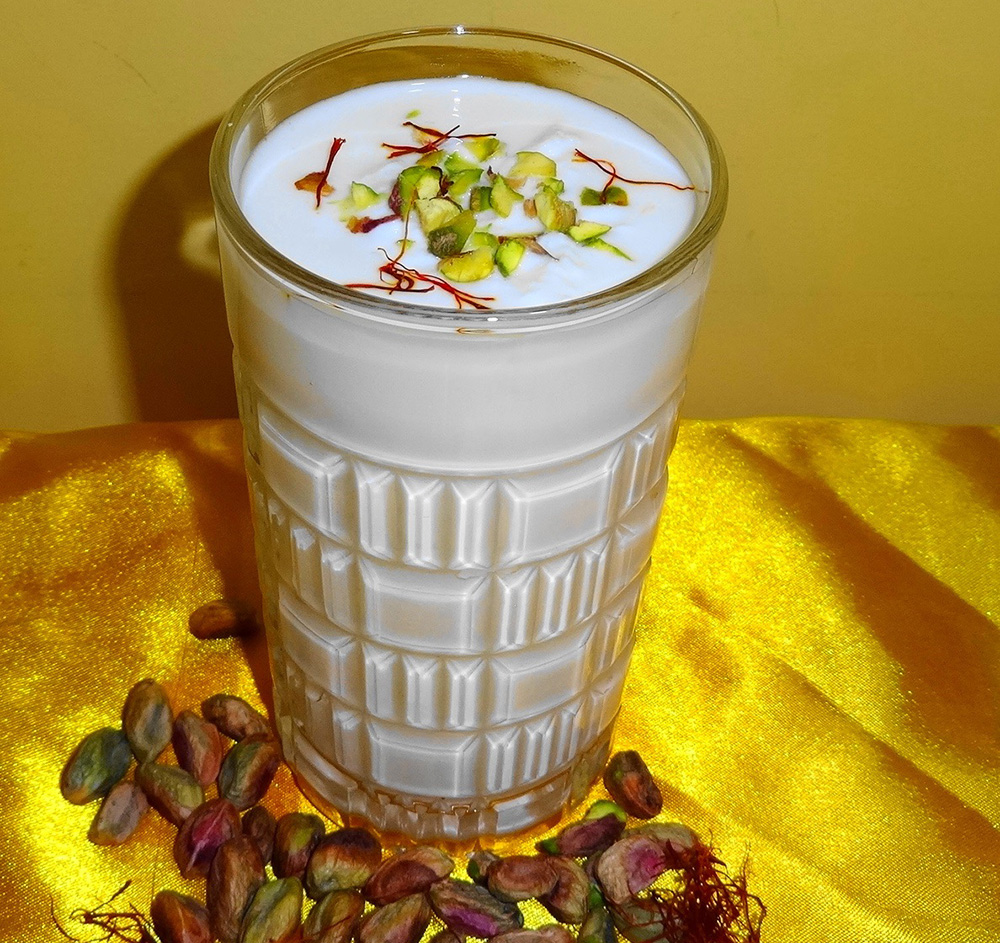
Patiala Lassi
Traditional Methods and Equipment of Cooking
Authentic Punjabi food is a result of different kinds of traditional cooking. One such important method is bhatti, similar to a masonry oven. Made with bricks and clay, the Punjabi bhatti is covered with a metal at the top. Any one side of the oven is kept open to ignite fire using wood and bamboo leaves. Another type of cooking style is, using a traditional stove called chulla. It is a common sight in the kitchens of Punjab to cook food using chulla, also commonly called band chulla and wadda chulla in the households of Punjab.
Another very popular style of cooking food is using a tandoor. Commonly found in Punjabi households, the tandoor has become an important equipment for preparing various Punjabi food items. A large part of the Punjabi cuisine comprises of tandoori items. In earlier times, communal tandoors were a cost-effective way to feed large groups as they stayed lit for long hours. A typical Punjabi tandoor is cylindrical in shape. It was originally made of clay with layers of insulating material like concrete or mud on the outside. These were then heated using wood or charcoal fire. Tandoors have commonly been used in South and Central Asia and throughout the Middle East, both to bake bread and to cook meat. This type of a clay oven was originally popularized during the Mughal reign in India. Now with the increasingly hectic life style, tandoors are no longer a part of everyday family life. These are now mostly restricted to restaurants or open spaces as they emit a lot of smoke.
Some of the other frequently used traditional kitchen equipment from a Punjabi household are madhani (wooden churner typically used for churning out butter), chakla belan (traditionally made of wood, chakla is a small round platform to make common Indian bread called roti and belan is a rolling pin), kadoo kas (an equipment used for grating like making puree of tomatoes which is heavily used in making Butter Chicken), patila (made up of brass and used to prepare a dish called Patila Chicken), dori danda (it is used for pounding leaves to make chutneys and powdered spices). Spices are traditionally ground in a ghotna (a kitchen equipment to grind spices and other ingredients).
Winter Delicacies: Sarson da Saag and Makki ki Roti
The state of Punjab lies in northern India and experiences extreme temperatures during the summer and winter seasons. The winter months start from early December and last till the end of February or early March. The temperature during these months can reach as low as two degrees. Chilly mornings and freezing nights call for warm foods and beverages. There are numerous dishes made exclusively in the winter months of Punjab. For example, the famous sarson ka saag and makki ki roti, cholle palak or palak paneer. Apart from the main dishes, winter months bring a variety of healthy bites famously known as Panjeeri, laddoos and variations of jaggery based dishes to keep the body warm.
Sarhon da Saag (Sarson ka Saag) is the most loved winter dish from the northern state of India, Punjab.During the harvest season, mustard fields are covered with sarsonkephool (mustard flowers). However, it is from the green mustard leaves that saag is prepared. From the month of November till February, sarson ka saag is consumed with joy. Saag is a combination of three types of leaves, that is, sarson (mustard leaves), palak (spinach) and bathua (white goosefoot leaves) to add colour and thickness. It is cooked with various spices and topped with a generous amount of desi ghee or white butter.
One of the most celebrated festivals in Punjab is Lohri. It marks the end of winter and the harvest of Rabi (winter) crops like wheat, barley, mustard and peas. On the day of the festival gudd-rewri (sweet made of jaggery), peanuts and popcorn are consumed. As a part of various rituals, it is considered auspicious to eat gajjak (a sweet made of sesame seeds or peanuts and jaggery), sarson ka saag and makki ki roti and til rice (rice made with jaggery and sesame seeds) on the day of Lohri. Sarson ka Saag, is best served with Makki ki roti, unprocessed butter, ek mukka maar kay gannda (hand-pressed onion), gudd (jaggery) and a big glass of namkeen or plain lassi.
The Famous Amritsari Kulcha
There are various cities in Punjab which are famous for its authentic food. These places attract tourists across the globe especially for food and experiencing the culinary specialities of Punjab. Places like Amritsar, Patiala, Jalandhar, Ludhiana are some of the most popular ones. The historic city of Amritsar is home to the world-famous Sikh shrine, Harmandir Sahib, famously called the Golden Temple. The narrow lanes of Amritsar are famous for their hidden dhabas or food stalls offering delicious food. One such dish is the famous Amritsari Kulche (a variant of naan). Traditionally, Kulche are made using the tandoor (an oven with origins in Central Asia). In this part of rural Punjab bread is baked in communal gatherings known as sanjha chulha. Historically, women used to gather around a common tandoor to bake fresh bread, in the process they also developed bonds whilst talking and cooking. The partition of India in 1947 involved mass movement of people from Pakistan and India. Many settled in the region of Punjab (India) and brought their traditional style of tandoori cooking with them. As a result, tandoor became an essential part of cooking among the local restaurants and eventually, throughout the country. Many of the existing cuisines were altered due to the amalgamation of different styles of cooking and a variety of recipes. For example, cholle were given a new alternative which came to be known as Pindi Cholle. Many such variants were offered by the dhabas which were opened in the lanes of Amritsar.
In Punjab, wheat is grown in abundance and has been used to create a variety of breads like roti, paranthe, naan and its local variant kulcha. The kulcha is notably eaten not just in northern India but also in Lahore and Peshawar. The famous Amritsari Kulcha is a stuffed soft textured bread. It is a popular Punjabi breakfast dish that is made by fermenting and aerating the wheat or maida (all-purpose flour). It is commonly made with stuffing of potato and onions, although these kulchas have multiple variations depending upon the season.
The hearty kulchas are served hot and, true to the food culture of the region of Punjab, they are generously smothered in ghee. The kulche is typically served in combination with cholle (Chickpea in semi thick curry, also called kabuli chana). Along with the cholle, kulche are also complemented with Imli Chuttney. The chuttney gives a beautiful burst of flavour made with onion, pudina, coriander and tamarind. Both of these combinations are popular street food dishes in Northern India. The cholle adds spiciness and the chuttney offers a delicious hint of tanginess. The best way to enjoy this dish is to tear off a piece of the kulcha and dip into the fiery and flavourful dry cholle and chuttney.
Winter Secured in a Glass Jar: Gobhi-Gajar-Shalgam ka Achaar
The land of Punjab consists of sandy loam soil which is great for growing vegetables like carrots, radish, pea, cauliflower, turnips and spinach. These are grown in the winter months and are considered to be extremely beneficial for the human body. Apart from creating famous desserts like gajar ka halwa, vegetables like carrot, radish, turnips and cauliflower are used to create the pickles (achaar). Pickles of India are deeply rooted in the Indian cooking and eating habits. The art of cooking without fire reminds one of childhood, where vacations were filled with assembling the ingredients carefully, helping the grandmother in preparing achaar and then waiting for it to be ready.
In India, pickling is considered to be one of the best ways to preserve a food item. Once preserved, it will have longer shelf life and it will not need refrigeration, thus making it ideal for it to be carried on long-distance journeys. Gobhi-gajar-shalgam ka achaar (cauliflower-carrot-turnip pickle) is a special from Punjab. It is a must have pickle during the winter season as these vegetables are available in plenty during this season. Many families make this pickle as soon as the vegetables are available in the market and enjoy throughout the season. This achaar is enjoyed with almost every winter dish especially with various stuffed paranthas. It is also savoured with the famous breakfast dish, Cholle Bhature.
 Government of India
Government of India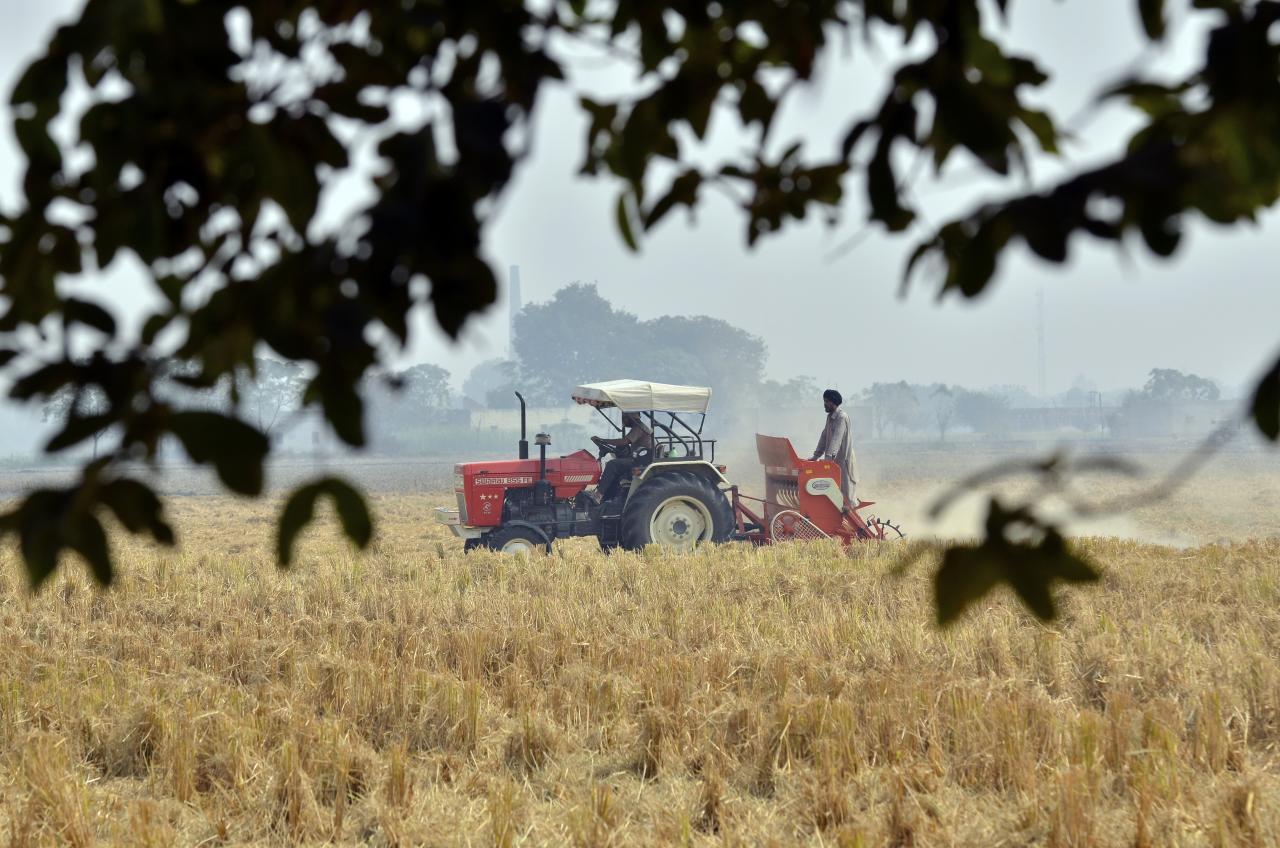
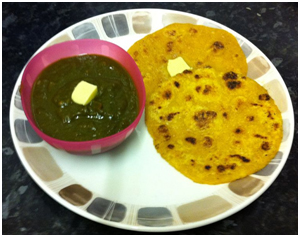
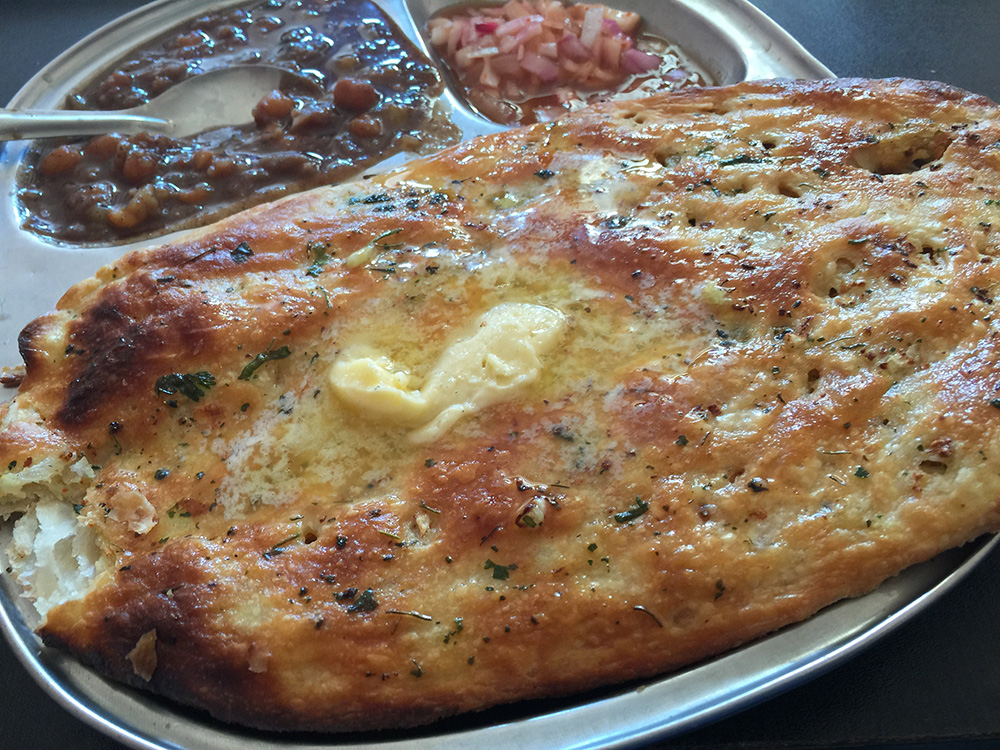
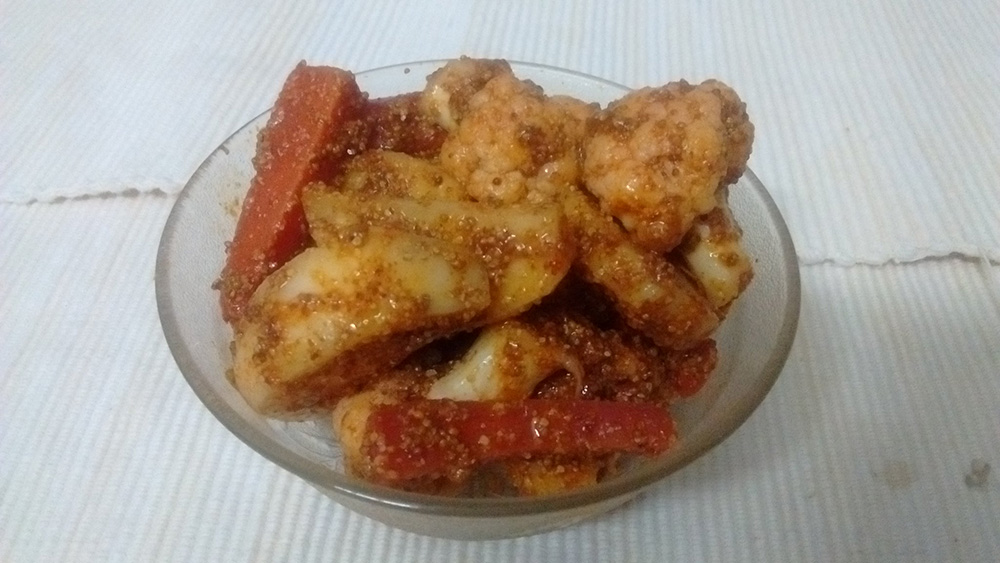


 Recognizing the ongoing need to position itself for the digital future, Indian Culture is an initiative by the Ministry of Culture. A platform that hosts data of cultural relevance from various repositories and institutions all over India.
Recognizing the ongoing need to position itself for the digital future, Indian Culture is an initiative by the Ministry of Culture. A platform that hosts data of cultural relevance from various repositories and institutions all over India.